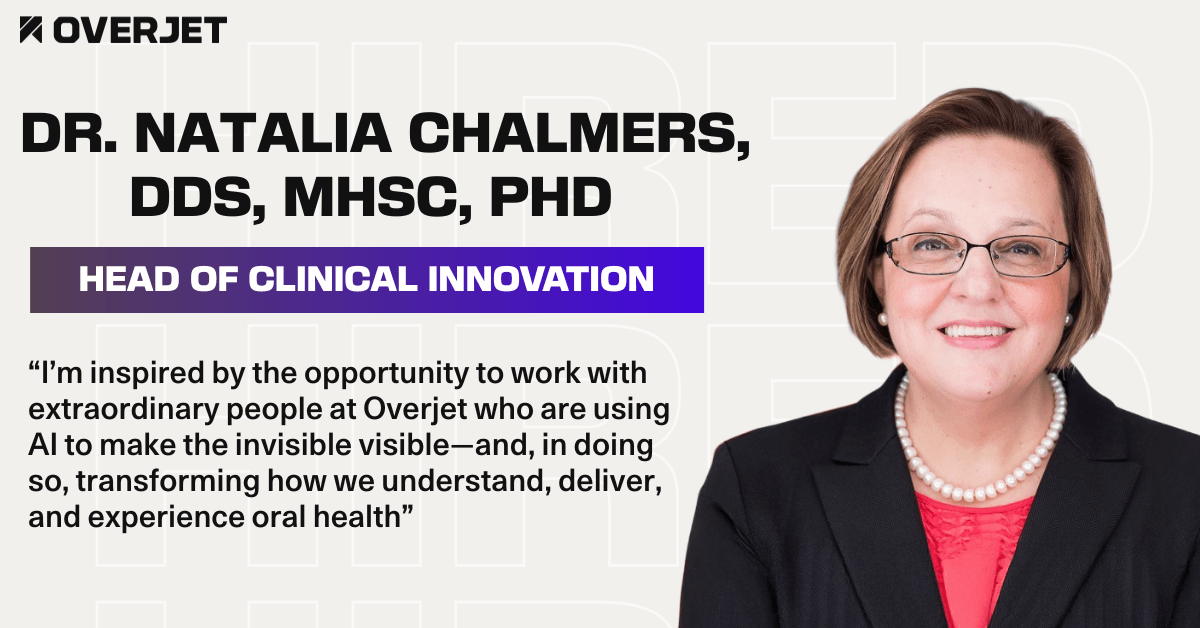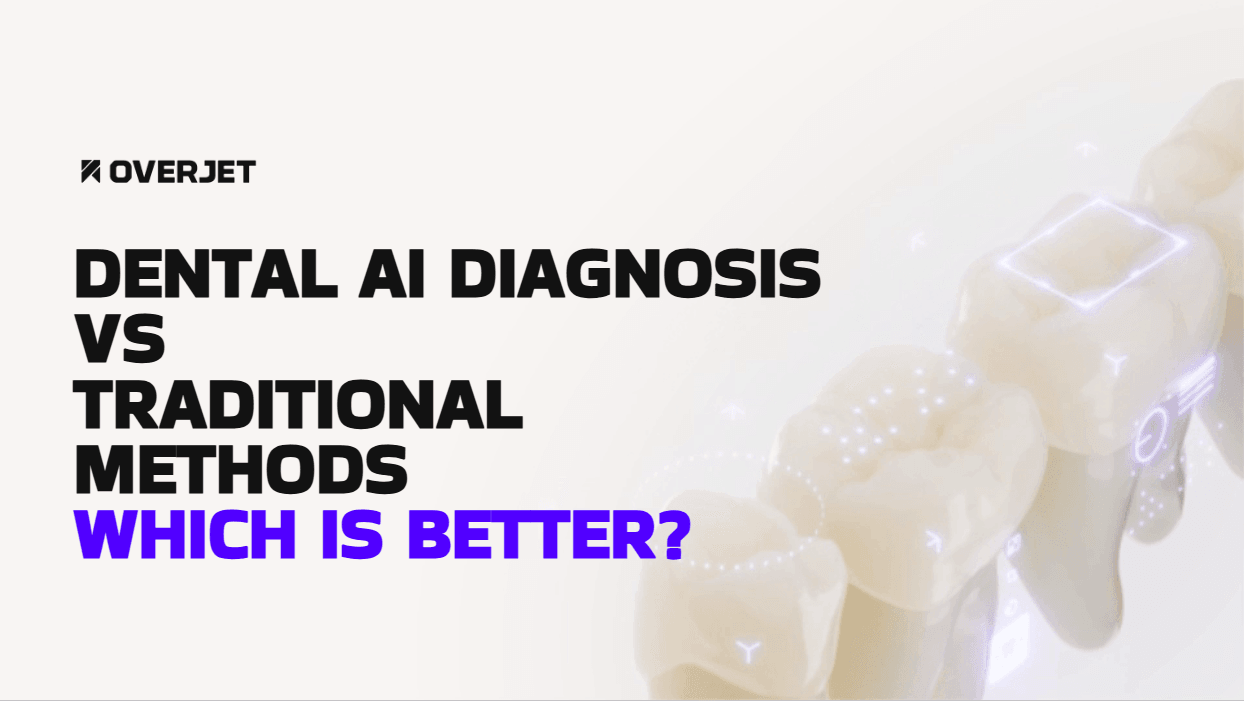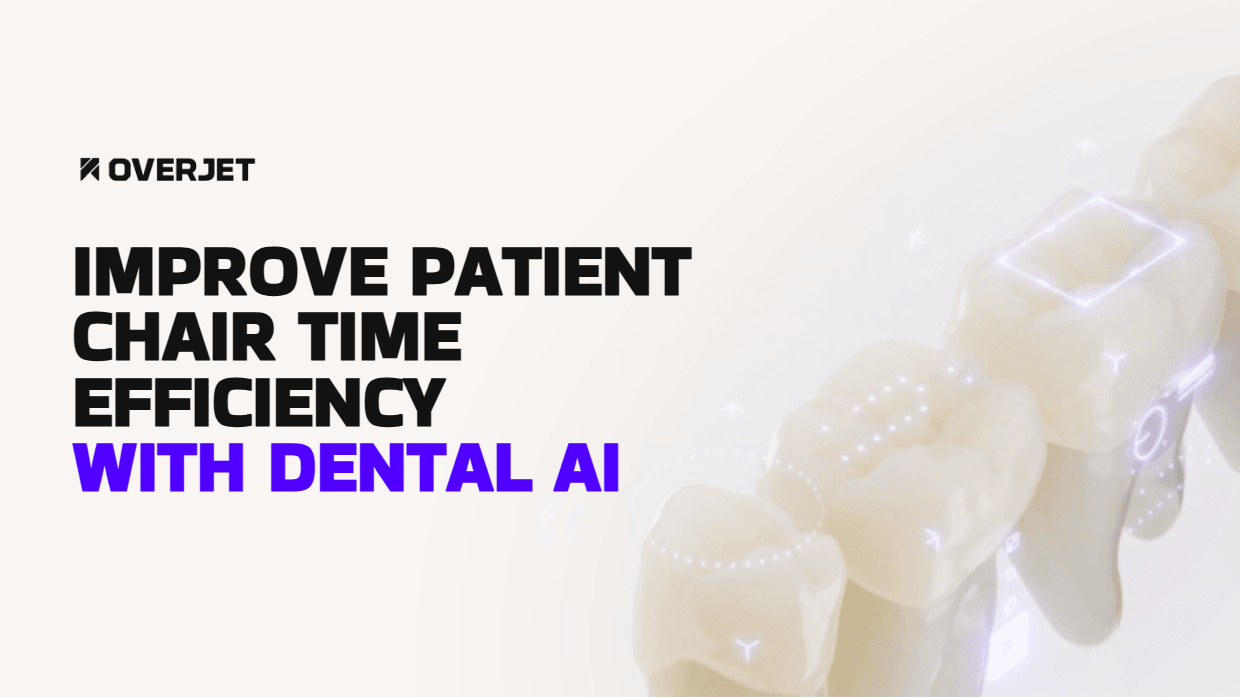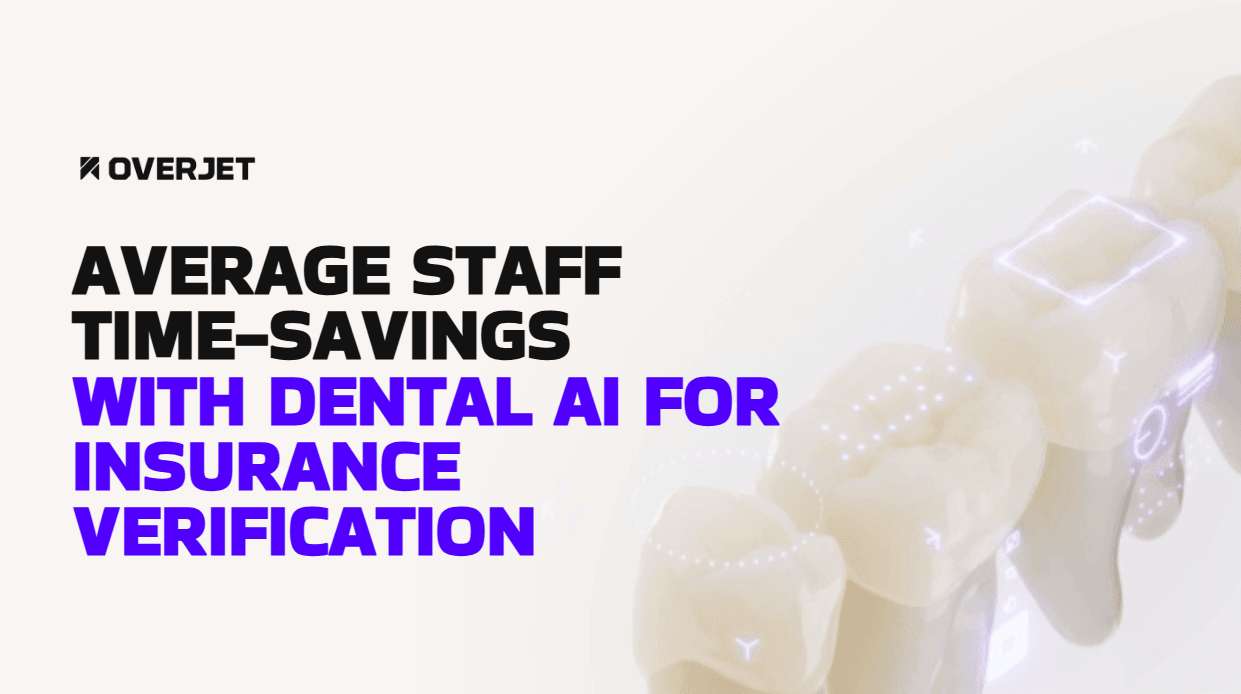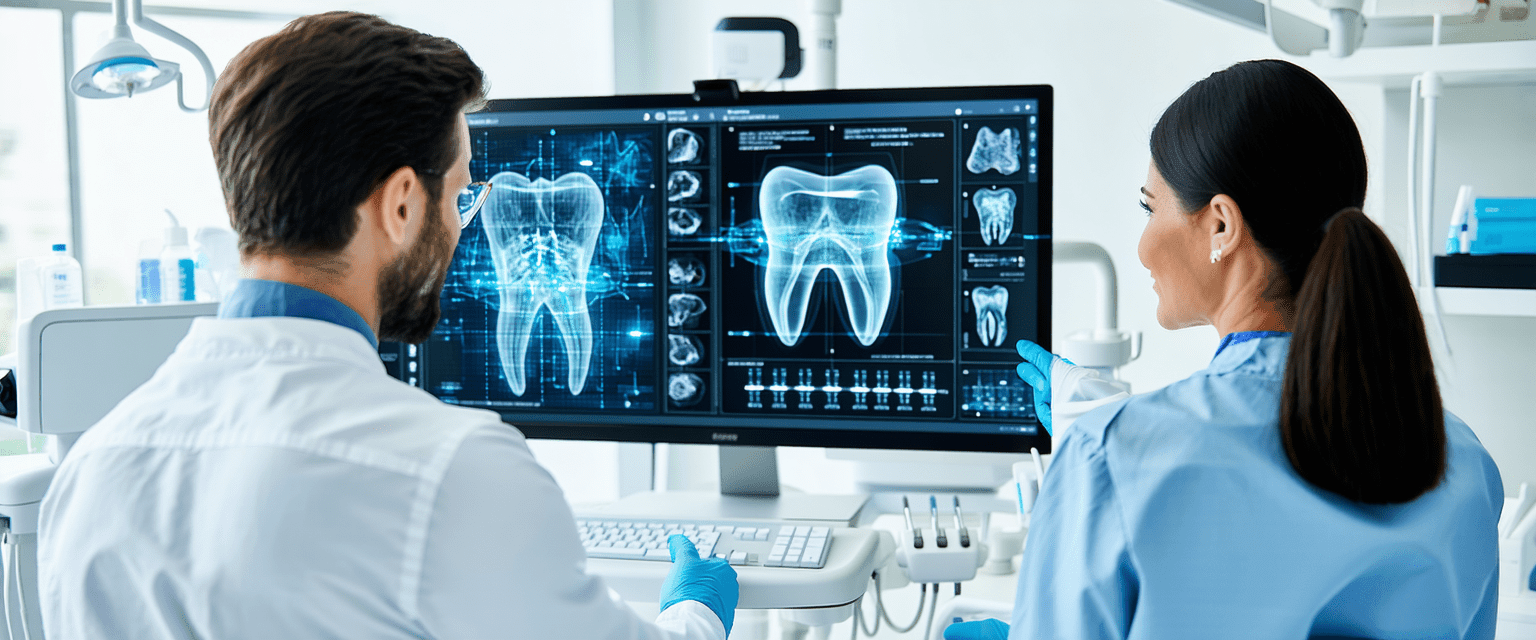Understanding dental practice revenue is critical for anyone considering practice ownership or evaluating their current financial performance. The average dental practice generates between $700,000 and $1 million annually, though specialty practices often exceed $1.5 million depending on their focus area and market conditions.
This breakdown examines revenue expectations across dental specialties, regional variations, overhead costs, and proven strategies for improving practice profitability. You’ll discover how factors like patient mix, technology adoption, and operational efficiency directly impact your bottom line.
Explore Overjet's Dental AI Software
Average Gross Dental Practice Revenue by Specialty
Dental practice revenue varies dramatically by specialty, with general practices typically generating $700,000 to $1 million annually while specialized practices often exceed $1.5 million per year. Location, patient volume, and service mix play crucial roles in determining overall revenue potential.
General Dentistry
General dental practices focus on routine cleanings, fillings, crowns, and basic oral health maintenance. Revenue typically ranges from $700,000 to $941,600 annually, with monthly collections between $65,000 and $120,000 depending on patient flow and geographic location.
Current data shows general dentistry practices report an annual gross billing of $666,060 to $942,290 (Average Dental Practice Revenue by Specialty: How Do You Compare?) (Dental Practice Research | American Dental Association), which aligns with the stated range of $700,000 to $941,600. However, revenue can vary more widely depending on factors such as location, practice size, and patient demographics.
The revenue model relies heavily on consistent patient relationships and insurance reimbursements. Rural practices often see lower revenue due to smaller patient populations, while suburban practices benefit from stable demographics and established referral networks.
Orthodontics
Orthodontic practices specialize in straightening teeth through braces, clear aligners, and other corrective appliances. Revenue often reaches $1.5 to $2 million annually due to higher treatment values and extended patient relationships spanning 18-24 months.
Treatment plans create predictable revenue streams since patients commit to multi-year care cycles. The specialty benefits from both pediatric and adult markets, with clear aligner technology significantly expanding the adult patient base.
Pediatric Dentistry
Pediatric dental practices serve patients from infancy through adolescence, emphasizing preventive care and early intervention. Revenue typically ranges from $1 million to $1.5 million annually, influenced by insurance coverage patterns and the focus on preventive services.
Patient volumes tend to be higher due to more frequent preventive visits every six months. However, procedures are generally less complex than adult treatments, resulting in moderate per-visit revenue compared to other specialties.
Oral Surgery
Oral surgery practices generate revenue through complex procedures including extractions, implant placement, and jaw surgeries. Many oral surgeons maintain hospital privileges, adding facility-based procedures that command premium fees.
Revenue varies widely based on case complexity and referral volume from general dentists. Practices focusing on dental implants often see higher revenue due to premium pricing for reconstructive procedures that can range from $3,000 to $6,000 per implant.
Periodontics
Periodontal practices specialize in gum disease treatment and prevention, generating revenue through both surgical interventions and ongoing maintenance therapy. The chronic nature of periodontal disease creates opportunities for long-term patient relationships.
Scaling and root planing: Deep cleaning procedures for early gum disease
Surgical procedures: Gum grafts and pocket reduction surgery
Maintenance visits: Quarterly cleanings for ongoing gum health
Implant services: Many periodontists also place dental implants
Endodontics
Endodontic practices focus exclusively on root canal therapy and related procedures. Per-procedure revenue tends to be high due to the specialized nature of treatment, with root canals typically ranging from $1,200 to $2,000 per tooth.
Most endodontic practices operate on referral relationships with general dentists. This model creates consistent case flow but requires maintaining strong professional relationships within the local dental community.
Prosthodontics
Prosthodontic practices specialize in complex restorative and reconstructive dentistry, including full mouth rehabilitation and advanced cosmetic procedures. Premium pricing reflects the complexity and artistry involved in comprehensive smile makeovers.
Revenue comes from high-value cases that may span several months and cost $20,000 to $80,000 per patient. The specialty attracts patients seeking comprehensive smile reconstruction after trauma, disease, or extensive dental problems.
Cosmetic Dentistry
Cosmetic dental practices focus on elective aesthetic procedures including veneers, teeth whitening, and smile design. Revenue ranges from $1.5 to $2.5 million annually, with higher profit margins due to the elective nature of treatments.
Patient demographics typically include higher-income individuals willing to invest in aesthetic improvements. Marketing plays a crucial role since cosmetic procedures are rarely covered by insurance, making patient education and case presentation critical for success.
National and Regional Benchmarks for Dental Revenue
Geographic location significantly impacts dental practice revenue through variations in cost of living, insurance reimbursement rates, and local demographics. Regional differences can create revenue variations of 30-50% between markets.
Northeast
Northeastern practices typically see higher gross revenues due to elevated fee schedules that offset increased overhead costs. Urban practices in cities like New York and Boston often generate $1.2 to $1.5 million annually, though high rent and labor costs impact net profitability.
Suburban practices balance moderate overhead with stable patient demographics. Insurance penetration tends to be higher, though reimbursement negotiations can be more challenging in saturated markets with multiple provider options.
South
Southern practices benefit from growing populations and expanding suburban markets. Revenue growth often correlates with population migration patterns, particularly in states like Texas, Florida, and North Carolina where retirees and young families are relocating.
Insurance coverage varies significantly across southern states. Practices in areas with limited Medicaid dental coverage may see higher cash-pay percentages, affecting revenue predictability but potentially improving profit margins.
Midwest
Midwestern practices typically operate with stable patient bases and moderate overhead costs. Revenue ranges tend to be more consistent, with less dramatic seasonal fluctuations compared to coastal markets that may see vacation-related scheduling changes.
Insurance penetration is generally strong, providing predictable reimbursement streams. However, fee schedules may be lower than coastal areas, requiring efficient operations and higher patient volumes to maintain profitability.
West
Western practices, particularly in California and Washington, often see the highest fee schedules nationally. However, overhead costs—especially real estate and labor—can be substantially higher, sometimes doubling compared to midwest markets.
Technology adoption rates tend to be higher in western markets. Early adopters of digital workflows and AI-powered diagnostics often achieve operational efficiencies that improve revenue per hour worked.
Average Dental Practice Revenue Breakdown and Overhead
Dental practices typically operate with overhead ranging from 60-70% of gross revenue, leaving 30-40% for owner compensation and profit. Breaking down these expenses reveals where revenue actually goes and identifies optimization opportunities.
Staff Compensation
Staff compensation represents the largest expense category, typically consuming 25-35% of gross revenue. This includes hygienists, dental assistants, front office staff, and any associate dentists working in the practice.
Dental hygienists usually command the highest wages among staff members while generating significant revenue through preventive services. Dental assistants support chairside efficiency, and administrative staff handle scheduling, insurance verification, and patient communications that keep the practice running smoothly.
Lab and Supplies
Laboratory fees and dental supplies typically account for 6-8% of gross revenue. Crown and bridge cases generate the highest lab expenses, while routine cleanings require minimal supply costs beyond basic instruments and materials.
Digital workflows can reduce lab costs while improving turnaround times for restorative procedures. In-office milling systems allow practices to create crowns the same day, eliminating lab fees while providing patient convenience.
Facility and Equipment
Facility costs including rent, utilities, and equipment financing typically represent 8-12% of gross revenue. Technology investments in digital radiography, intraoral scanners, and CAD/CAM systems require significant capital but can improve efficiency and patient experience.
Equipment leasing allows practices to access advanced technology without large upfront investments. However, lease costs accumulate over time and may exceed purchase prices for equipment used long-term.
Marketing and Patient Acquisition
Marketing expenses typically range from 2-5% of gross revenue, though new practices may invest more heavily in patient acquisition. Digital marketing, including search engine optimization and social media, has become increasingly important for attracting new patients.
Patient acquisition costs vary significantly by specialty and location. Cosmetic practices may invest 8-10% of revenue in marketing due to the elective nature of services, while specialty practices often rely more on referral relationships with general dentists.
Insurance and Administration
Professional liability insurance, credentialing costs, and administrative overhead typically consume 3-5% of gross revenue. Insurance verification, claims processing, and patient billing create ongoing administrative expenses that directly impact profitability.
Automated systems can reduce administrative overhead while improving accuracy. Overjet’s automated insurance verification and claims processing helps practices reduce administrative burden while accelerating payment cycles, directly improving cash flow.
Net Income for Dentists and Owner Salary Expectations
The average net income for general dentists in private practice is $207,980, according to 2024 ADA data (Dental Practice Research | American Dental Association). For specialists, the current figure is $338,900.
Average Profit Margin and EBITDA
Healthy dental practices typically achieve profit margins of 40% or higher, meaning total overhead stays below 60% of gross revenue. EBITDA (Earnings Before Interest, Taxes, Depreciation, and Amortization) provides a clearer picture of operational profitability by excluding non-cash expenses.
Benchmark EBITDA for dental practices ranges from 25-35% of gross revenue. Practices achieving higher EBITDA margins often demonstrate superior operational efficiency through optimized scheduling, effective case presentation, and streamlined administrative processes.
Dentist Private Practice Income vs. Associate Pay
Practice ownership offers higher earning potential but requires business management responsibilities and financial risk. Associate dentists typically earn $150,000-$250,000 annually with predictable paychecks and fewer administrative headaches.
Ownership benefits include equity building, tax advantages, and unlimited earning potential. However, owners also bear responsibility for staff management, equipment purchases, marketing, and business development activities that associates can avoid.
Dental Practice Owner Salary and Cash Flow
Practice owners typically draw 25-35% of gross revenue as personal compensation, though this varies based on practice maturity and reinvestment needs. Cash flow management becomes crucial for practices investing in expansion or new technology upgrades.
Owner compensation may fluctuate based on seasonal patterns and major equipment purchases. Successful practice owners often reinvest 10-15% of revenue back into practice improvements, technology upgrades, and continuing education to maintain competitive advantages.
Key 2025 Trends Shaping Dental Revenue
Several industry trends are reshaping dental practice economics, from insurance pressures to workforce challenges. Understanding these shifts helps practices adapt their revenue strategies and operational approaches.
PPO Fee Compression
Insurance reimbursement rates continue facing downward pressure while practice costs increase annually. Many PPO plans have not increased fee schedules proportionally to inflation, effectively reducing real reimbursement rates year over year.
Fee schedule negotiations become increasingly important for maintaining profitability. Some practices are selectively dropping lower-reimbursing plans or transitioning toward fee-for-service models to maintain revenue per procedure.
Hygiene Workforce Dynamics
Dental hygienist shortages in many markets are driving up compensation costs while potentially limiting revenue growth. Hygiene departments typically generate 30-35% of practice revenue, making staffing stability crucial for financial performance.
Alternative staffing models, including expanded function dental assistants, help practices maintain productivity despite hygienist shortages. Some practices are exploring part-time arrangements and flexible scheduling to attract available hygienists in competitive markets.
Same-Day and Subscription Dentistry Demand
Patient preferences increasingly favor convenience and predictable costs. Same-day crown technology and subscription-based preventive care models are reshaping traditional dental economics and patient expectations.
Subscription models provide predictable revenue streams while improving patient retention rates. However, practices must carefully price these programs to maintain profitability while delivering genuine value to participating patients.
DSO and Private Equity Expansion
Dental support organizations and private equity investment continue expanding, creating both opportunities and competitive pressures for independent practices. DSOs often achieve economies of scale that allow more competitive pricing and comprehensive benefits packages.
Independent practices may need to focus on personalized service and advanced technology to differentiate themselves. Some practitioners are exploring partnership opportunities that provide capital for growth while maintaining clinical autonomy.
Factors That Influence Dental Practice Revenue
Multiple variables beyond specialty choice determine practice revenue potential. Patient demographics, operational efficiency, and local market conditions all play significant roles in financial performance.
Patient Mix and Retention
The balance between insurance and fee-for-service patients significantly impacts revenue predictability and profitability. Cash-paying patients typically generate higher margins but may be more price-sensitive and less predictable.
Patient retention rates directly affect revenue stability and marketing costs. Practices with strong retention typically see 80-90% of patients return annually, reducing expensive new patient acquisition while building long-term relationships.
Case Acceptance Rate
Treatment plan acceptance rates vary widely among practices, typically ranging from 60-85%. Higher acceptance rates directly translate to increased revenue from existing patient visits without additional marketing expenses.
Clear communication and visual aids significantly improve case acceptance rates. Overjet’s AI-powered imaging provides clear, annotated visuals that help patients understand their diagnoses, leading to improved treatment acceptance and better patient outcomes.
Scheduling and Chair Utilization
Efficient scheduling maximizes revenue per hour and reduces overhead costs per procedure. Practices achieving 85% or higher chair utilization typically outperform less efficient competitors in profitability metrics.
Block scheduling and template optimization help practices maximize productivity throughout the day. Reducing cancellations and no-shows through automated reminder systems also improves daily production consistency and staff efficiency.
Technology Adoption Level
Practices investing in digital workflows often achieve higher efficiency and improved patient experiences. Digital radiography, intraoral cameras, and CAD/CAM systems streamline procedures while enhancing diagnostic capabilities and patient communication.
AI-powered diagnostic tools like Overjet’s FDA-cleared imaging software improve diagnostic accuracy and speed. This technology allows practices to identify more treatment opportunities while providing better patient care and clearer treatment explanations.
Strategies to Increase Dental Practice Revenue and Profit Margin
Implementing targeted approaches can significantly improve practice financial performance. The most effective methods focus on both revenue enhancement and operational efficiency improvements.
1. Optimize Appointment Scheduling
Block scheduling and template optimization maximize chair utilization while reducing gaps between appointments. Efficient scheduling can increase daily production by 15-25% without adding additional overhead costs or staff members.
Same-day scheduling opportunities help capture urgent care revenue while improving patient satisfaction. Maintaining open appointment slots for emergency cases can generate higher-margin urgent care revenue that often pays better than routine procedures.
2. Improve Case Acceptance With Visual AI Aids
Patient education tools significantly increase treatment acceptance rates by helping patients understand their oral health conditions. Visual aids make complex diagnoses more comprehensible and compelling for patient decision-making.
Overjet’s AI imaging technology provides clear, annotated visuals that help patients understand their diagnoses and treatment needs. Clear visual explanations improve treatment acceptance rates while building patient trust and confidence in recommended procedures.
3. Diversify High-Margin Services
Adding profitable procedures to the service mix can substantially increase revenue without proportional overhead increases. Sleep apnea treatment, facial aesthetics, and implant services often generate premium margins compared to routine procedures.
Service diversification also improves patient retention by providing comprehensive care within one practice location. Patients appreciate the convenience of receiving multiple services from their trusted dental provider rather than seeking referrals elsewhere.
4. Reduce No-Shows With Automated Reminders
Communication systems using text messages and email reminders can reduce no-show rates from 15-20% down to under 5%. Improved attendance directly translates to increased daily production and better schedule efficiency.
Confirmation systems that allow patients to reschedule online help fill cancelled appointments more quickly. Some practices also implement same-day reminder calls for additional confirmation, particularly for longer or more expensive appointments.
5. Streamline Insurance Verification and Claims
Administrative efficiency in insurance processing reduces overhead while accelerating payment cycles. Automated verification systems prevent scheduling patients without confirmed coverage, avoiding collection problems later.
Overjet’s automated claim review and processing reduces administrative burden while improving accuracy and speed. Faster claim processing and fewer denials improve cash flow by reducing accounts receivable aging and collection efforts.
How AI Technology Boosts Revenue and Cuts Overhead
Artificial intelligence is transforming dental practice operations by improving diagnostic accuracy, streamlining administrative processes, and enhancing patient communication. These improvements directly impact both revenue generation and cost control.
AI-Driven Radiograph Diagnosis
AI-powered diagnostic tools enhance clinical accuracy while reducing interpretation time for busy practitioners. Consistent, standardized diagnoses help practices identify treatment opportunities that might otherwise be missed during routine examinations.
Overjet’s FDA-cleared AI detects oral diseases with high precision, supporting comprehensive diagnosis and treatment planning. Improved diagnostic accuracy leads to more complete treatment plans and better long-term patient outcomes.
Automated Claim Review and Payment Acceleration
Insurance claim processing automation reduces administrative overhead while improving accuracy and submission speed. Automated systems can identify potential claim issues before submission, significantly reducing denial rates and resubmission work.
Faster claim processing improves practice cash flow by reducing payment cycles from weeks to days. Overjet’s automated claim review accelerates payment processing while reducing the administrative burden on front office staff.
Real-Time Patient Education Tools
Visual communication tools improve patient understanding and treatment acceptance rates significantly. Clear, annotated imaging helps patients see and understand their oral health conditions more effectively than verbal explanations alone.
Interactive patient education increases case acceptance while building trust and confidence in treatment recommendations. Patients who understand their conditions are more likely to accept recommended treatments and maintain regular preventive care schedules.
Putting the Numbers in Perspective for 2025 Growth
Dental practice revenue expectations vary significantly based on specialty choice, market conditions, and operational efficiency. While revenue benchmarks provide useful targets, profitability ultimately depends on effective cost management and exceptional patient care delivery.
Technology investments like Overjet’s AI platform can improve both clinical outcomes and financial performance by streamlining workflows and enhancing patient communication. Practices that embrace technological innovation often achieve competitive advantages in efficiency and patient satisfaction.
The dental industry continues evolving rapidly, with successful practices adapting to changing patient expectations and market conditions. Focus on delivering exceptional patient care while maintaining operational excellence creates the foundation for sustainable revenue growth and long-term success.
Ready to See Overjet's Dental AI in Action?
Frequently Asked Questions (FAQs)
What is dental practice software and why is AI important?
Dental practice software helps manage key areas like scheduling, billing, imaging, and patient records. With AI integration, these tools go further, automating radiograph analysis, improving diagnostic accuracy, and reducing administrative workload. AI makes the software smarter, faster, and more effective.
How does AI improve radiograph interpretation?
AI is trained on millions of dental images and can detect signs of caries, bone loss, and other conditions with precision. This supports more accurate diagnoses, faster treatment planning, and helps dentists maintain consistent standards across providers.
Can AI really reduce claim denials and boost revenue?
Yes. AI can verify insurance eligibility in real time, help document procedures more accurately, and flag potential coding errors. This leads to cleaner claims, fewer denials, and faster reimbursements, ultimately improving financial performance.
Is AI difficult to implement in a dental practice?
Not with the right support. Platforms like Overjet offer expert onboarding and training, helping practices start with high-impact features like radiograph analysis. The transition is designed to be smooth and non-disruptive to your daily workflow.
Why choose Overjet over other dental AI platforms?
Overjet is the only dental AI company with FDA clearance for detecting both caries and bone loss. It’s trusted by leading DSOs and private practices, integrates with existing systems, and delivers measurable improvements in clinical and financial outcomes.



